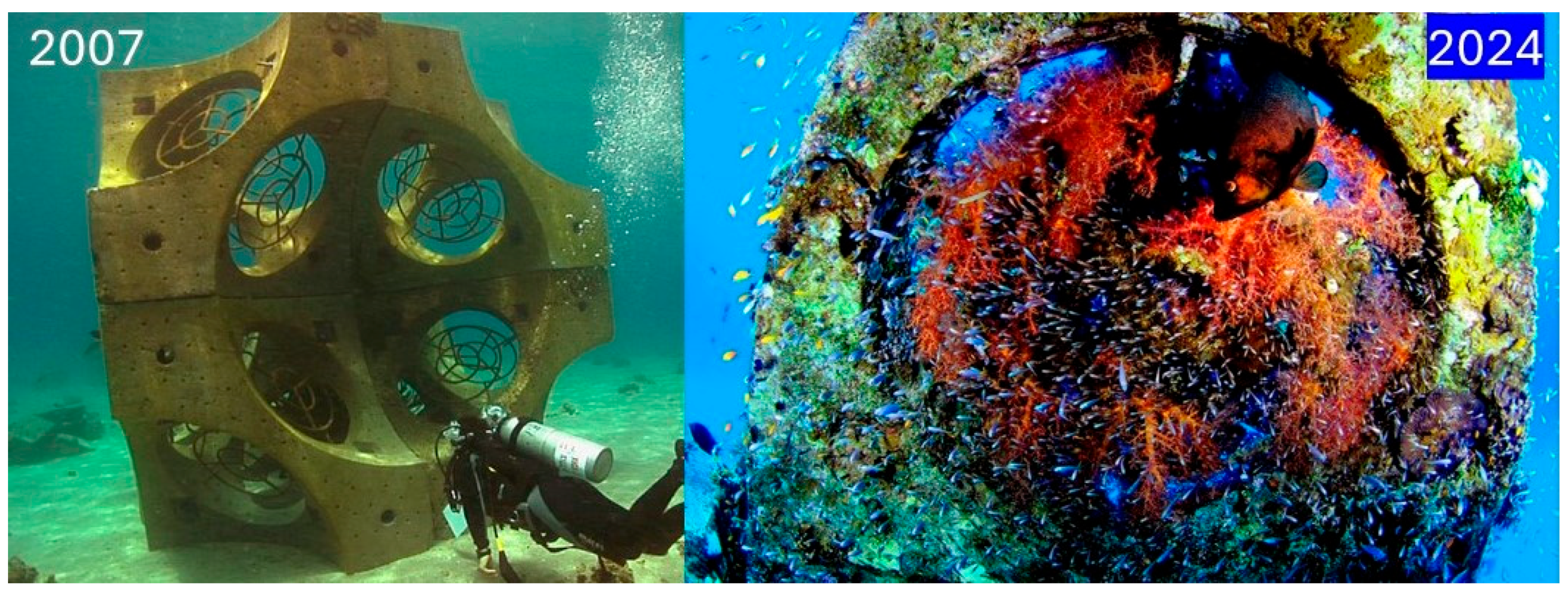Reply to Zvuloni, A.; Shaked, Y. Comment on “Shashar et al. Artificial Reef Deployment Reduces Diving Pressure from Natural Reefs—The Case of Introductory Dives in Eilat, Red Sea. Oceans 2024, 5, 71–80”
1. Introduction
2. Choice of Diving Routes and Alternative Dive Site
3. Effects of Natural Pressures and Disasters on the Reefs
4. Conclusions
Author Contributions
Funding
Institutional Review Board Statement
Informed Consent Statement
Data Availability Statement
Acknowledgments
Conflicts of Interest
References
- Shashar, N.; Oren, A.; Neri, R.; Waizman, O.; Chernihovsky, N.; Tynyakov, J. Artificial Reef Deployment Reduces Diving Pressure from Natural Reefs—The Case of Introductory Dives in Eilat, Red Sea. Oceans 2024, 5, 71–80. [Google Scholar] [CrossRef]
- Zvuloni, A.; Shaked, Y. Comment on Shashar et al. Artificial Reef Deployment Reduces Diving Pressure from Natural Reefs—The Case of Introductory Dives in Eilat, Red Sea. Oceans 2024, 5, 71–80. Oceans 2025, 6, 23. [Google Scholar] [CrossRef]
- Neri, R.; Oren, A.; Shashar, N. Evaluating recreational diving pressure and diver-wildlife interactions on natural and artificial reefs utilizing social media data mining. In Proceedings of the ECRS-European Coral Reef Symposium, Naples, Italy, 2–5 July 2024. [Google Scholar]
- Lennox, R.J.; Sbragaglia, V.; Vollset, K.W.; Sortland, L.K.; McClenachan, L.; Jarić, I.; Guckian, M.L.; Ferter, K.; Danylchuk, A.J.; Cooke, S.J.; et al. Digital fisheries data in the Internet age: Emerging tools for research and monitoring using online data in recreational fisheries. Fish Fish. 2022, 23, 926–940. [Google Scholar] [CrossRef]
- Retka, J.; Jepson, P.; Ladle, R.J.; Malhado, A.C.; Vieira, F.A.; Normande, I.C.; Souza, C.N.; Bragagnolo, C.; A Correia, R. Assessing cultural ecosystem services of a large marine protected area through social media photographs. Ocean Coast. Manag. 2019, 176, 40–48. [Google Scholar] [CrossRef]
- Kirkbride-Smith, A.E.; Wheeler, P.M.; Johnson, M.L. The relationship between diver experience levels and perceptions of attractiveness of artificial reefs–examination of a potential management tool. PLoS ONE 2013, 8, e68899. [Google Scholar] [CrossRef]
- Polak, O.; Shashar, N. Can a small artificial reef reduce diving pressure from a natural coral reef? Lessons learned from Eilat, Red Sea. Ocean. Coast. Manag. 2012, 55, 94–100. [Google Scholar] [CrossRef]
- Sumanapala, D.; Dimmock, K.; Wolf, I.D. A review of ecological impacts from recreational SCUBA diving: Current evidence and future practice. Tour. Hosp. Res. 2023, 23, 564–577. [Google Scholar] [CrossRef]
- Bideci, C.; Cater, C. In search of underwater atmosphere: A new diving world on artificial reefs. In Atmospheric Turn in Culture and Tourism: Place, Design and Process Impacts on Customer Behaviour, Marketing and Branding; Volgger, M., Pfister, D., Eds.; Emerald: New York, NY, USA, 2019; pp. 245–257. [Google Scholar] [CrossRef]
- Tynyakov, J.; Rousseau, M.; Chen, M.; Figus, O.; Belhassen, Y.; Shashar, N. Artificial reefs as a means of spreading diving pressure in a coral reef environment. Ocean. Coast. Manag. 2017, 149, 159–164. [Google Scholar] [CrossRef]
- Firth, L.B.; Farnworth, M.; Fraser, K.P.; McQuatters-Gollop, A. Make a difference: Choose artificial reefs over natural reefs to compensate for the environmental impacts of dive tourism. Sci. Total Environ. 2023, 901, 165488. [Google Scholar] [CrossRef] [PubMed]



Disclaimer/Publisher’s Note: The statements, opinions and data contained in all publications are solely those of the individual author(s) and contributor(s) and not of MDPI and/or the editor(s). MDPI and/or the editor(s) disclaim responsibility for any injury to people or property resulting from any ideas, methods, instructions or products referred to in the content. |
© 2025 by the authors. Licensee MDPI, Basel, Switzerland. This article is an open access article distributed under the terms and conditions of the Creative Commons Attribution (CC BY) license (https://creativecommons.org/licenses/by/4.0/).
Share and Cite
Shashar, N.; Neri, R.; Oren, A.; Tynyakov, J. Reply to Zvuloni, A.; Shaked, Y. Comment on “Shashar et al. Artificial Reef Deployment Reduces Diving Pressure from Natural Reefs—The Case of Introductory Dives in Eilat, Red Sea. Oceans 2024, 5, 71–80”. Oceans 2025, 6, 24. https://doi.org/10.3390/oceans6020024
Shashar N, Neri R, Oren A, Tynyakov J. Reply to Zvuloni, A.; Shaked, Y. Comment on “Shashar et al. Artificial Reef Deployment Reduces Diving Pressure from Natural Reefs—The Case of Introductory Dives in Eilat, Red Sea. Oceans 2024, 5, 71–80”. Oceans. 2025; 6(2):24. https://doi.org/10.3390/oceans6020024
Chicago/Turabian StyleShashar, Nadav, Re’em Neri, Asa Oren, and Jenny Tynyakov. 2025. "Reply to Zvuloni, A.; Shaked, Y. Comment on “Shashar et al. Artificial Reef Deployment Reduces Diving Pressure from Natural Reefs—The Case of Introductory Dives in Eilat, Red Sea. Oceans 2024, 5, 71–80”" Oceans 6, no. 2: 24. https://doi.org/10.3390/oceans6020024
APA StyleShashar, N., Neri, R., Oren, A., & Tynyakov, J. (2025). Reply to Zvuloni, A.; Shaked, Y. Comment on “Shashar et al. Artificial Reef Deployment Reduces Diving Pressure from Natural Reefs—The Case of Introductory Dives in Eilat, Red Sea. Oceans 2024, 5, 71–80”. Oceans, 6(2), 24. https://doi.org/10.3390/oceans6020024






